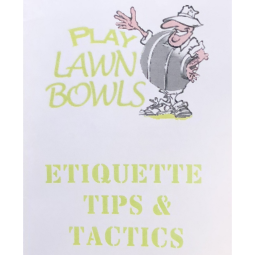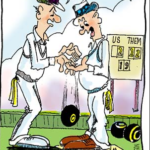
Bowls Etiquette
The Club Umpires have suggested we could all benefit from some regular reminders of good bowls etiquette, whether we are playing Competition or Social bowls.
Therefore on a regular basis an Etiquette point will be placed below.
=========================================================================
The Third
The responsibility of the third is to control the head while the skip is on the mat. The third should however, wait for the skip to ask his opinion about the head and advice about the shot selection but ultimately, the final shot selection rests with the skip.
Always provide concise and accurate answers when the skip is on the mat.
Once all bowls have been delivered the thirds are required to measure to agree on the final score of each end.
Consider all the bowls which may be in the count, and confirm with your opponent third that all possibilities have been measured. Indicate using your hand, the number of shots won or lost on the end by displaying fingers up or down, and voice it clearly.
Retrieving any bowls from the ditch or wherever they finish and are not in play is also good etiquette.
Possession of the mat / Rink passes to the other side when your bowl comes to rest. You should then wait for your next turn on the mat before exchanging information with your skip.
DO’s and DON’T’s
1. If your Skip has first bowl, place his bowl on the mat before crossing over.
2. Listen to any comments offered by your Skip, and don’t give instructions to your Skip on the crossover. They have just left the head, and will have a plan of their own.
3. If the opposition has the mat (It’s their turn to bowl), Don’t speak to your skip, or step into the head until after their bowl has come to rest.
4. Call for an umpire to measure if an agreement cannot be reached with the opposition, and then stand back so that they can do their job.
5. ‘Dead bowls’ are removed by the opposition. (After agreement that the bowl is dead).
6. Remove chalk marks from touchers after the end has been completed. Remove chalk marks from opponents bowls if they have not been removed by them after the preceding end.
7. Signal the score clearly after confirmation with the opposition’s third, to the skip and scorers.
8. Anyone can measure, but usually the overseer of the potentially losing bowl goes first.
9. The losing third should pick up the jack and hand it to the winning lead.
10. Watch for bowls from adjacent rinks, that may disrupt the head on your own rink, and be ready to lift your bowl or stop the offending bowl.
11. Never go into the adjacent rink to lift or stop a bowl. That is the responsibility of the person overseeing the head on their rink. You must ask them to respond if they have not seen the potential disruption.
Etiquette includes knowing your own Role and Responsibilities, and should be led from the Skip
Cohesive teams often perform better and have greater success.
The skip should lead the team with confidence by being clear with instructions and supportive of any special needs. Provide encouragement before, during and after the game.
Everyone will play some bad bowls and no bowler is likely to deliver every bowl just how they want it; the skips role is to play the best bowls they can and refrain from showing any adverse emotions at bad bowls played by anyone.
Body language can affect team confidence so remain focused on the game and your team.
Remain still while standing at the head to avoid distracting your own team and opponents.Green Etiquette
-
-
- Bowling Greens should be treated with respect. Most Clubs have synthetic surfaces which are expensive and time consuming to be repaired or replaced.
- Don’t Drop your bowl onto the green, stand in the ditches, or sit on the bank.
- Don’t stand in the ditches, or sit on the bank edges.
- Don’t “Dump”. There is no formal rule or finite definition for “Dumping”, but the general rule of thumb is that the bowl should not be delivered from a Knee height or above. (Apply common sense – ‘Casting a bowl in a looping trajectory’ or ‘driving the bowl into the ground on delivery’, could also damage a green and be deemed to be dumping)
-
Etiquette Simply Means “Displaying Fairness, Consideration and Good Sportsmanship”
Bowls is a sport that encourages social interaction and friendship. Etiquette simply means displaying “good sportsmanship”. This is achieved by having knowledge of what behaviour is acceptable in the game and applying it using common sense, honesty, fairness and consideration of others.
If unsure about something relating to etiquette it is acceptable to ask questions.
Etiquette applies to persons playing, marking, umpiring and spectating at a game of bowls and also to members of a Club.
Etiquette is an important part of lawn bowls and all Clubs and their members should not only practice it, but inform new members what is proper and expected behaviour on the green and in the clubhouse.
Thoughtfulness and common sense are the keys to etiquette.Players and spectators at the head and mat ends, should stand still and remain quiet each time a person gets on the mat to deliver their bowl. (No distractions)
Show respect for every opponent you play by never moving about while they are on the mat, or making noise while they are about to deliver a bowl.
There are specific rules regarding standing behind the mat or behind the head.
Bowlers should not crowd around the head after delivering the bowls, only those that need to be there should be there.
When asking a player or players, to move, be sure to be polite, courteous and show good sportsmanship at all time.
Here are 5 Basic Lawn Bowl Rules one should know:
Mat Placement: The first to play places the mat on the centre line at least 2 metres from the ditch and up to the hog line if desired. The Hog line in domestic play, is 23 metres from the opposite ditch)
Foot Faulting: BEFORE Delivery, a player must have part of one foot on the mat, and AT Delivery / Release, All or Part of one foot on or above the mat.
Jack / Bowl Length: A jack Must travel 21 metres within the rink to be legal, while a bowl Must travel 14 metres within the rink to be in play.
Jack Delivery: If the jack is improperly delivered, the opposition may reposition the mat and deliver the jack but not play first. If the jack is improperly delivered by both leads, the jack is placed at the 2 metre mark at the centre of the rink, and the first to play may reposition the mat.
Position of Players on Rink: Players at the mat end who are not delivering a bowl, should stand at least 1 metre behind the mat. Players at the head end who are not controlling play, should stand behind the head at least 2 metres from the jack, and off the rink if the jack gets moved to the ditch.

